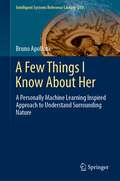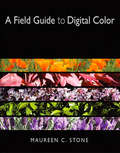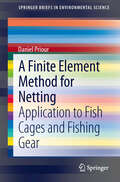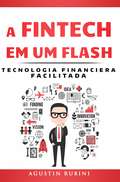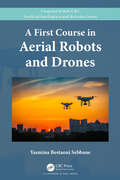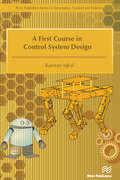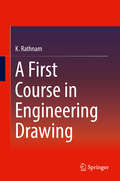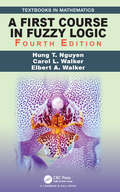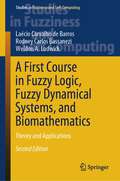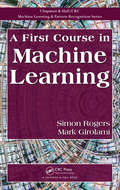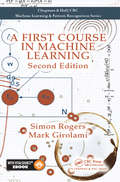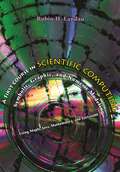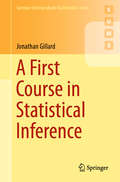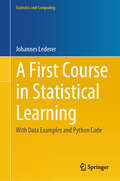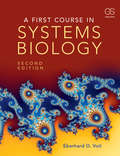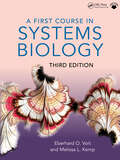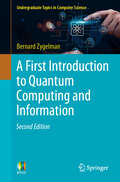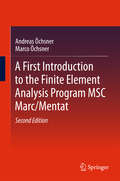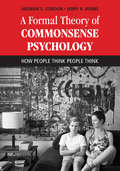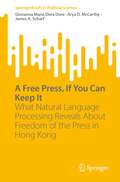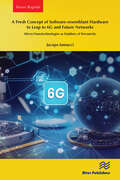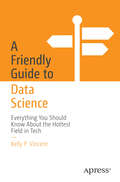- Table View
- List View
A Few Things I Know About Her: A Personally Machine Learning Inspired Approach to Understand Surrounding Nature (Intelligent Systems Reference Library #219)
by Bruno ApolloniThis book reconsiders key issues, such as description and explanation, which affect data analytics. For starters: the soul does not exist. Once released from this cumbersome roommate, we are left with complex biological systems: namely, ourselves, who must configure their environment in terms of worlds that are compatible with what they sense. Far from supplying yet another cosmogony, the book provides the cultivated reader with computational tools for describing and understanding data arising from his surroundings, such as climate parameters or stock market trends, even the win/defeat story of his son football team. Besides the superposition of the very many universes considered by quantum mechanics, we aim to manage families of worlds that may have generated those data through the key feature of their compatibility. Starting from a sharp engineering of ourselves in term of pairs consisting of genome plus a neuron ensemble, we toss this feature in different cognitive frameworks within a span of exploitations ranging from probability distributions to the latest implementations of machine learning. From the perspective of human society as an ensemble of the above pairs, the book also provides scientific tools for analyzing the benefits and drawbacks of the modern paradigm of the world as a service.
A Field Guide to Digital Color
by Maureen StoneMaureen Stone's field guide to digital color presents a survey of digital color with special emphasis on those fields important for computer graphics. The book provides the foundation for understanding color and its applications, discusses color media and color management and the use of color in computer graphics, including color design and selecti
A Finite Element Method for Netting: Application to fish cages and fishing gear (SpringerBriefs in Environmental Science)
by Daniel PriourThis book fully describes a finite element method for netting. That describes the relation between forces and deformation of the netting. That takes into account forces due to the twine elasticity, the hydrodynamic forces, the catch effect, the mesh opening stiffness. This book is divided in 5 parts. The first section contains introduction on the finite element method, the second part is about equilibrium calculation, the third presents a triangular element for netting, the fourth and fifth are for cable and node element. The sixth presents few validation cases.
A Fintech em um Flash
by Fernanda Belokurows Agustin RubiniFinalmente um guia explicativo de tecnologia financeira! A indústria de tecnologia de serviços financeiros está crescendo, com investimentos superiores a US$20 bilhões só no ano passado. Existem mais de 5000 startups de fintech operando e 50 delas já alcançaram uma avaliação de bilhões de dólares. O alcance deste mercado vai até os pagamentos online. A tecnologia financeira promete mudar a forma como gerimos o nosso dinheiro online, quebrando barreiras no cenário do setor de serviços financeiros. Compreender suas muitas facetas é a chave para nadar nas águas das nuances complexas desta indústria global. O livro “A Fintech em um Flash” é o seu guia explicativo sobre o futuro do setor bancário e de seguros. O livro pretende identificar os conceitos-chave de forma a ajudá-lo a entender todos os aspectos, a fim de que você possa aproveitar essas novas tecnologias. Dentro, você encontrará uma série de tópicos interessantes, como pagamentos online, financiamento coletivo, bancos challengers, seguros online, empréstimos digitais, Big Data e comércio eletrônico. Isso irá fazer você repensar a maneira como administra o seu dinheiro online e até mesmo encontrar novas formas de realizar pagamentos online. Abrangente, organizado e detalhado, este guia é a sua fonte de acesso para tudo o que você precisa para navegar com confiança neste cenário em constante mudança desta indústria em expansão.
A First Course in Aerial Robots and Drones (Chapman & Hall/CRC Artificial Intelligence and Robotics Series)
by Yasmina Bestaoui SebbaneA First Course in Aerial Robots and Drones provides an accessible and student friendly introduction to aerial robots and drones. Drones figure prominently as opportunities for students to learn various aspects of aerospace engineering and design. Drones offer an enticing entry point for STEM studies. As the use of drones in STEM studies grows, there is an emerging generation of drone pilots who are not just good at flying, but experts in specific niches, such as mapping or thermography. Key Features: Focuses on algorithms that are currently used to solve diverse problems. Enables students to solve problems and improve their science skills. Introduces difficult concepts with simple, accessible examples. Suitable for undergraduate students, this textbook provides students and other readers with methods for solving problems and improving their science skills.
A First Course in Control System Design
by Kamran IqbalControl systems are pervasive in our lives. Our homes have environmental controls. The appliances we use at home, such as the washing machine, microwave, etc. have embedded controllers. We fly in airplanes and drive automobiles, which make extensive use of control systems. The increasing automation in the past few decades has increased our reliance on control systems.A First Course in Control System Design discusses control systems design from a model-based perspective as applicable to single-input single-output systems. The emphasis in this book is on understanding and applying the techniques that enable the design of effective control systems. The book covers the time-domain and the frequency-domain design methods, as well as the design of continuous-time and discrete-time systems.Technical topics discussed in the book include: Modeling of physical systems Analysis of transfer function and state variable models Control system design via root locus Control system design in the state-space Control design of sampled-data systems Compensator design via frequency response modification
A First Course in Electrical and Computer Engineering
by Louis ScharfElectrical and computer engineering textbook
A First Course in Engineering Drawing
by K. RathnamThe primary objective of this book is to provide an easy approach to the basic principles of Engineering Drawing, which is one of the core subjects for undergraduate students in all branches of engineering. Further, it offers comprehensive coverage of topics required for a first course in this subject, based on the author's years of experience in teaching this subject. Emphasis is placed on the precise and logical presentation of the concepts and principles that are essential to understanding the subject. The methods presented help students to grasp the fundamentals more easily. In addition, the book highlights essential problem-solving strategies and features both solved examples and multiple-choice questions to test their comprehension.
A First Course in Fuzzy Logic (Textbooks in Mathematics)
by Hung T. Nguyen Elbert A. Walker Carol L. Walker<p>A First Course in Fuzzy Logic, Fourth Edition is an expanded version of the successful third edition. It provides a comprehensive introduction to the theory and applications of fuzzy logic. <p>This popular text offers a firm mathematical basis for the calculus of fuzzy concepts necessary for designing intelligent systems and a solid background for readers to pursue further studies and real-world applications. <p>New in the Fourth Edition: <p> <li>Features new results on fuzzy sets of type-2 <li>Provides more information on copulas for modeling dependence structures <li>Includes quantum probability for uncertainty modeling in social sciences, especially in economics</li> <p>With its comprehensive updates, this new edition presents all the background necessary for students, instructors and professionals to begin using fuzzy logic in its many—applications in computer science, mathematics, statistics, and engineering. </p>
A First Course in Fuzzy Logic, Fuzzy Dynamical Systems, and Biomathematics: Theory and Applications (Studies in Fuzziness and Soft Computing #432)
by Rodney Carlos Bassanezi Weldon A. Lodwick Laécio Carvalho de BarrosThis book provides an essential introduction to the field of dynamical models. Starting from classical theories such as set theory and probability, it allows readers to draw near to the fuzzy case. On one hand, the book equips readers with a fundamental understanding of the theoretical underpinnings of fuzzy sets and fuzzy dynamical systems. On the other, it presents some concepts of derivatives, integrals and differential equations applied to the context of fuzzy functions. Each of the major topics is accompanied by examples, worked-out exercises, and exercises to be completed. Moreover, many applications to real problems are presented, mainly in biomathematics where the so-called p-fuzzy systems play an important role. The book has been developed on the basis of the authors’ lectures to university students and is accordingly primarily intended as a textbook for both upper-level undergraduates and graduates in applied mathematics, statistics, and engineering. It also offers a valuable resource for practitioners such as mathematical consultants and modelers, and for researchers alike, as it may provide both groups with new ideas and inspirations for projects in the fields of fuzzy logic and biomathematics. This thoroughly updated second edition includes a new chapter on fuzzy optimization, which also presents an application in carbon markets analysis and modeling
A First Course in Machine Learning
by Mark GirolamiA First Course in Machine Learning covers the core mathematical and statistical techniques needed to understand some of the most popular machine learning algorithms. The algorithms presented span the main problem areas within machine learning: classification, clustering and projection. The text gives detailed descriptions and derivations for a smal
A First Course in Machine Learning
by Mark Girolami Simon Rogers"A First Course in Machine Learning by Simon Rogers and Mark Girolami is the best introductory book for ML currently available. It combines rigor and precision with accessibility, starts from a detailed explanation of the basic foundations of Bayesian analysis in the simplest of settings, and goes all the way to the frontiers of the subject such as infinite mixture models, GPs, and MCMC."—Devdatt Dubhashi, Professor, Department of Computer Science and Engineering, Chalmers University, Sweden "This textbook manages to be easier to read than other comparable books in the subject while retaining all the rigorous treatment needed. The new chapters put it at the forefront of the field by covering topics that have become mainstream in machine learning over the last decade."—Daniel Barbara, George Mason University, Fairfax, Virginia, USA "The new edition of A First Course in Machine Learning by Rogers and Girolami is an excellent introduction to the use of statistical methods in machine learning. The book introduces concepts such as mathematical modeling, inference, and prediction, providing ‘just in time’ the essential background on linear algebra, calculus, and probability theory that the reader needs to understand these concepts."—Daniel Ortiz-Arroyo, Associate Professor, Aalborg University Esbjerg, Denmark "I was impressed by how closely the material aligns with the needs of an introductory course on machine learning, which is its greatest strength…Overall, this is a pragmatic and helpful book, which is well-aligned to the needs of an introductory course and one that I will be looking at for my own students in coming months."—David Clifton, University of Oxford, UK "The first edition of this book was already an excellent introductory text on machine learning for an advanced undergraduate or taught masters level course, or indeed for anybody who wants to learn about an interesting and important field of computer science. The additional chapters of advanced material on Gaussian process, MCMC and mixture modeling provide an ideal basis for practical projects, without disturbing the very clear and readable exposition of the basics contained in the first part of the book." —Gavin Cawley, Senior Lecturer, School of Computing Sciences, University of East Anglia, UK "This book could be used for junior/senior undergraduate students or first-year graduate students, as well as individuals who want to explore the field of machine learning…The book introduces not only the concepts but the underlying ideas on algorithm implementation from a critical thinking perspective."—Guangzhi Qu, Oakland University, Rochester, Michigan, USA
A First Course in Scientific Computing: Symbolic, Graphic, and Numeric Modeling Using Maple, Java, Mathematica, and Fortran90
by Rubin LandauThis book offers a new approach to introductory scientific computing. It aims to make students comfortable using computers to do science, to provide them with the computational tools and knowledge they need throughout their college careers and into their professional careers, and to show how all the pieces can work together. Rubin Landau introduces the requisite mathematics and computer science in the course of realistic problems, from energy use to the building of skyscrapers to projectile motion with drag. He is attentive to how each discipline uses its own language to describe the same concepts and how computations are concrete instances of the abstract. Landau covers the basics of computation, numerical analysis, and programming from a computational science perspective. The first part of the printed book uses the problem-solving environment Maple as its context, with the same material covered on the accompanying CD as both Maple and Mathematica programs; the second part uses the compiled language Java, with equivalent materials in Fortran90 on the CD; and the final part presents an introduction to LaTeX replete with sample files. Providing the essentials of computing, with practical examples, A First Course in Scientific Computing adheres to the principle that science and engineering students learn computation best while sitting in front of a computer, book in hand, in trial-and-error mode. Not only is it an invaluable learning text and an essential reference for students of mathematics, engineering, physics, and other sciences, but it is also a consummate model for future textbooks in computational science and engineering courses. A broad spectrum of computing tools and examples that can be used throughout an academic career Practical computing aimed at solving realistic problems Both symbolic and numerical computations A multidisciplinary approach: science + math + computer science Maple and Java in the book itself; Mathematica, Fortran90, Maple and Java on the accompanying CD in an interactive workbook format
A First Course in Statistical Inference (Springer Undergraduate Mathematics Series)
by Jonathan GillardThis book offers a modern and accessible introduction to Statistical Inference, the science of inferring key information from data. Aimed at beginning undergraduate students in mathematics, it presents the concepts underpinning frequentist statistical theory.Written in a conversational and informal style, this concise text concentrates on ideas and concepts, with key theorems stated and proved. Detailed worked examples are included and each chapter ends with a set of exercises, with full solutions given at the back of the book. Examples using R are provided throughout the book, with a brief guide to the software included. Topics covered in the book include: sampling distributions, properties of estimators, confidence intervals, hypothesis testing, ANOVA, and fitting a straight line to paired data.Based on the author’s extensive teaching experience, the material of the book has been honed by student feedback for over a decade. Assuming only some familiarity with elementary probability, this textbook has been devised for a one semester first course in statistics.
A First Course in Statistical Learning: With Data Examples and Python Code (Statistics and Computing)
by Johannes LedererThis textbook introduces the fundamental concepts and methods of statistical learning. It uses Python and provides a unique approach by blending theory, data examples, software code, and exercises from beginning to end for a profound yet practical introduction to statistical learning. The book consists of three parts: The first one presents data in the framework of probability theory, exploratory data analysis, and unsupervised learning. The second part on inferential data analysis covers linear and logistic regression and regularization. The last part studies machine learning with a focus on support-vector machines and deep learning. Each chapter is based on a dataset, which can be downloaded from the book's homepage. In addition, the book has the following features: A careful selection of topics ensures rapid progress. An opening question at the beginning of each chapter leads the reader through the topic. Expositions are rigorous yet based on elementary mathematics. More than two hundred exercises help digest the material. A crisp discussion section at the end of each chapter summarizes the key concepts and highlights practical implications. Numerous suggestions for further reading guide the reader in finding additional information. This book is for everyone who wants to understand and apply concepts and methods of statistical learning. Typical readers are graduate and advanced undergraduate students in data-intensive fields such as computer science, biology, psychology, business, and engineering, and graduates preparing for their job interviews.
A First Course in Statistical Programming with R
by W. John Braun Duncan J. MurdochThis is the only introduction you'll need to start programming in R, the open-source language that is free to download, and lets you adapt the source code for your own requirements. Co-written by one of the R Core Development Team, and by an established R author, this book comes with real R code that complies with the standards of the language. Unlike other introductory books on the ground-breaking R system, this book emphasizes programming, including the principles that apply to most computing languages, and techniques used to develop more complex projects. Learning the language is made easier by the frequent exercises and end-of-chapter reviews that help you progress confidently through the book. Solutions, datasets and any errata will be available from the book's web site. The many examples, all from real applications, make it particularly useful for anyone working in practical data analysis.
A First Course in Systems Biology
by Eberhard VoitA First Course in Systems Biology is an introduction for advanced undergraduate and graduate students to the growing field of systems biology. Its main focus is the development of computational models and their applications to diverse biological systems. The book begins with the fundamentals of modeling, then reviews features of the molecular inventories that bring biological systems to life and discusses case studies that represent some of the frontiers in systems biology and synthetic biology. In this way, it provides the reader with a comprehensive background and access to methods for executing standard systems biology tasks, understanding the modern literature, and launching into specialized courses or projects that address biological questions using theoretical and computational means. New topics in this edition include: default modules for model design, limit cycles and chaos, parameter estimation in Excel, model representations of gene regulation through transcription factors, derivation of the Michaelis-Menten rate law from the original conceptual model, different types of inhibition, hysteresis, a model of differentiation, system adaptation to persistent signals, nonlinear nullclines, PBPK models, and elementary modes. The format is a combination of instructional text and references to primary literature, complemented by sets of small-scale exercises that enable hands-on experience, and large-scale, often open-ended questions for further reflection.
A First Course in Systems Biology
by Eberhard Voit Melissa L. KempA First Course in Systems Biology, Third Edition is an introduction to the growing field of systems biology for advanced undergraduates and graduate students. Its focus is the design and analysis of computational models and their applications to diverse biomedical phenomena, from simple networks and kinetics to complex pathway systems, signal transduction, personalized medicine, and interacting populations. The book begins with the fundamentals of computational modeling, then reviews features of the molecular inventories that bring biological systems to life and ends with case studies that reflect some of the frontiers in systems biology. In this way, the First Course provides the reader with a comprehensive background and with access to methods for executing standard tasks of biomedical systems analysis, exposure to the modern literature, and a foundation for launching into specialized projects that address biomedical questions with theoretical and computational means.This third edition has been thoroughly updated. It provides an introduction to agent-based and multiscale modeling, a deeper account of biological design principles, and the optimization of metabolic flux distributions. This edition also discusses novel topics of synthetic biology, personalized medicine, and virtual clinical trials that are just emerging on the horizon of this field.
A First Introduction to Quantum Computing and Information (Undergraduate Topics in Computer Science)
by Bernard ZygelmanThis textbook addresses and introduces new developments in the field of quantum information and computing (QIC) for a primary audience of undergraduate students. Developments over the past few decades have spurred the need for QIC courseware at major research institutions. To address this, the present 2nd edition of a highly accessible textbook/reference broadens the exposure of QIC science for the undergraduate market. The subject matter is introduced in such a way so that it is accessible to students with only a first-year calculus background. Greater accessibility allows a broader range of academic offerings. Topics and features: Introduces beginning undergraduate students to quantum theory and developments in QIC, without exposure to upper-level physics and mathematics Contains a new chapter on Adiabatic Quantum Computing Integrates Mathematica-based software examples and projects, which offers a “hands-on" experience and facilitates navigation of difficult abstract concepts Offers helpful links to additional exercises, problems, and solution manuals Facilitates a more holistic approach to the teaching of difficult concepts, incorporating symbolic manipulation software Provides new material on Quantum Error Correction Allows a broad-range of course offerings spanning physics, engineering, math and computer science This unique introductory textbook can serve courses offered in university physics, engineering, math, and definitely computer science departments. Use of Mathematica software allows a fast learning curve for students who have limited experience with scientific programming.
A First Introduction to the Finite Element Analysis Program MSC Marc/Mentat
by Andreas Öchsner Marco ÖchsnerThis book offers a brief introduction to the general-purpose finite element program MSC Marc, focusing on providing simple examples, often single-element problems, which can easily be related to the theory that is discussed in finite element lectures. As such, it is an ideal companion book to classical introductory courses on the finite element method. MSC Marc is a specialized program for non-linear problems (implicit solver), which is distributed by the MSC Software Corporation and commonly used in academia and industry. The documentation of all finite element programs now includes a variety of step-by-step examples of differing complexity, and all software companies offer professional workshops on different topics. Since the first edition of the book, there have been several new releases of Marc/Mentat and numerous changes. This new edition incorporates the latest Marc/Mentat software developments and new examples.
A Formal Theory of Commonsense Psychology: How People Think People Think
by Andrew S. Gordon Jerry R. HobbsCommonsense psychology refers to the implicit theories that we all use to make sense of people's behavior in terms of their beliefs, goals, plans, and emotions. These are also the theories we employ when we anthropomorphize complex machines and computers as if they had humanlike mental lives. In order to successfully cooperate and communicate with people, these theories will need to be represented explicitly in future artificial intelligence systems. This book provides a large-scale logical formalization of commonsense psychology in support of humanlike artificial intelligence. It uses formal logic to encode the deep lexical semantics of the full breadth of psychological words and phrases, providing fourteen hundred axioms of first-order logic organized into twenty-nine commonsense psychology theories and sixteen background theories. This in-depth exploration of human commonsense reasoning for artificial intelligence researchers, linguists, and cognitive and social psychologists will serve as a foundation for the development of humanlike artificial intelligence.
A Framework for K-12 Science Education
by Helen QuinnScience, engineering, and technology permeate nearly every facet of modern life and hold the key to solving many of humanity's most pressing current and future challenges. The United States' position in the global economy is declining, in part because U. S. workers lack fundamental knowledge in these fields. To address the critical issues of U. S. competitiveness and to better prepare the workforce, A Framework for K-12 Science Education proposes a new approach to K-12 science education that will capture students' interest and provide them with the necessary foundational knowledge in the field. A Framework for K-12 Science Education outlines a broad set of expectations for students in science and engineering in grades K-12. These expectations will inform the development of new standards for K-12 science education and, subsequently, revisions to curriculum, instruction, assessment, and professional development for educators. This book identifies three dimensions that convey the core ideas and practices around which science and engineering education in these grades should be built. These three dimensions are: crosscutting concepts that unify the study of science through their common application across science and engineering; scientific and engineering practices; and disciplinary core ideas in the physical sciences, life sciences, and earth and space sciences and for engineering, technology, and the applications of science. The overarching goal is for all high school graduates to have sufficient knowledge of science and engineering to engage in public discussions on science-related issues, be careful consumers of scientific and technical information, and enter the careers of their choice. A Framework for K-12 Science Education is the first step in a process that can inform state-level decisions and achieve a research-grounded basis for improving science instruction and learning across the country. The book will guide standards developers, teachers, curriculum designers, assessment developers, state and district science administrators, and educators who teach science in informal environments.
A Free Press, If You Can Keep It: What Natural Language Processing Reveals About Freedom of the Press in Hong Kong (SpringerBriefs in Political Science)
by Giovanna Maria Dore Arya D. McCarthy James A. ScharfThis Brief introduces a novel research approach to investigate freedom of the press in Hong Kong. The authors pair computational analyses from the field of natural language processing with qualitative content analysis of patterns of journalistic practice in volatile political settings. Together, these shed light on the evolution of press freedom in Hong Kong since its return to Chinese sovereignty. Providing an interdisciplinary perspective, the Brief will appeal to a wide range of readers with interests in computational social science, public policy, political sciences as well as policy-makers, think tanks, and practitioners who focus on the China-Hong Kong nexus.
A Fresh Concept of Software-resemblant Hardware to Leap to 6G and Future Networks: Micro/Nanotechnologies as Enablers of Pervasivity
by Jacopo IannacciFor a decade, with the uptake of 4G, we have become accustomed to the relentless increase in data and services on the move. The deployment of 5G is advancing crucial key performance indicators (KPIs), along with quality of service (QoS). Setting the horizon to 2030 and later, 6G will take the KPIs to numbers 100–1000 times better than 5G. Yet, the actual disruption of 6G and future networks (FN) will take place following other unprecedented paths.Artificial intelligence (AI) will be exploited in a threadlike fashion, at any level of the network physical infrastructure. This will introduce, to date unknown features, like self-sustaining, self-evolution and high-resilience of small portions of the infrastructure, pioneering the concept of a network of networks. Each segment of the infrastructure will bear a high degree of independence, while working at the same time as a whole, in full orchestration with the rest of the network.Given such a scenario, this book claims that the established and currently in use paradigms for the design and development of hardware–software (HW–SW) systems, are not appropriate to address the challenges of 6G and, further ahead, of FN. In response, unprecedented design approaches are suggested, relying on a fresh reinterpretation of the standard concept of HW, with specific attention to the network edge and edge intelligence (EI).This work develops some conceptual tools that may help address the technical challenges resulting from the intricate scenario sketched above. Within the mentioned HW reconceptualization, a pivotal role is forecasted for microtechnologies and nanotechnologies, intended with a broad meaning, which embraces, among others, devices, systems (MEMS/NEMS) and materials.
A Friendly Guide to Data Science: Everything You Should Know About the Hottest Field in Tech (Friendly Guides to Technology)
by Kelly P. VincentUnlock the world of data science—no coding required. Curious about data science but not sure where to start? This book is a beginner-friendly guide to what data science is and how people use it. It walks you through the essential topics—what data analysis involves, which skills are useful, and how terms like &“data analytics&” and &“machine learning&” connect—without getting too technical too fast. Data science isn&’t just about crunching numbers, pulling data from a database, or running fancy algorithms. It&’s about asking the right questions, understanding the process from start to finish, and knowing what&’s possible (and what&’s not). This book teaches you all of that, while also introducing important topics like ethics, privacy, and security—because working with data means thinking about people, too. Whether you're a student exploring new skills, a professional navigating data-driven decisions, or someone considering a career change, this book is your friendly gateway into the world of data science, one of today&’s most exciting fields. No coding or programming experience? No problem. You'll build a solid foundation and gain the confidence to engage with data science concepts— just as AI and data become increasingly central to everyday life. What You Will Learn Grasp foundational statistics and how it matters in data analysis and data science Understand the data science project life cycle and how to manage a data science project Examine the ethics of working with data and its use in data analysis and data science Understand the foundations of data security and privacy Collect, store, prepare, visualize, and present data Identify the many types of machine learning and know how to gauge performance Prepare for and find a career in data science Who This Book is for A wide range of readers who are curious about data science and eager to build a strong foundation. Perfect for undergraduates in the early semesters of their data science degrees, as it assumes no prior programming or industry experience. Professionals will find particular value in the real-world insights shared through practitioner interviews. Business leaders can use it to better understand what data science can do for them and how their teams are applying it. And for career changers, this book offers a welcoming entry point into the field—helping them explore the landscape before committing to more intensive learning paths like degrees or boot camps.
